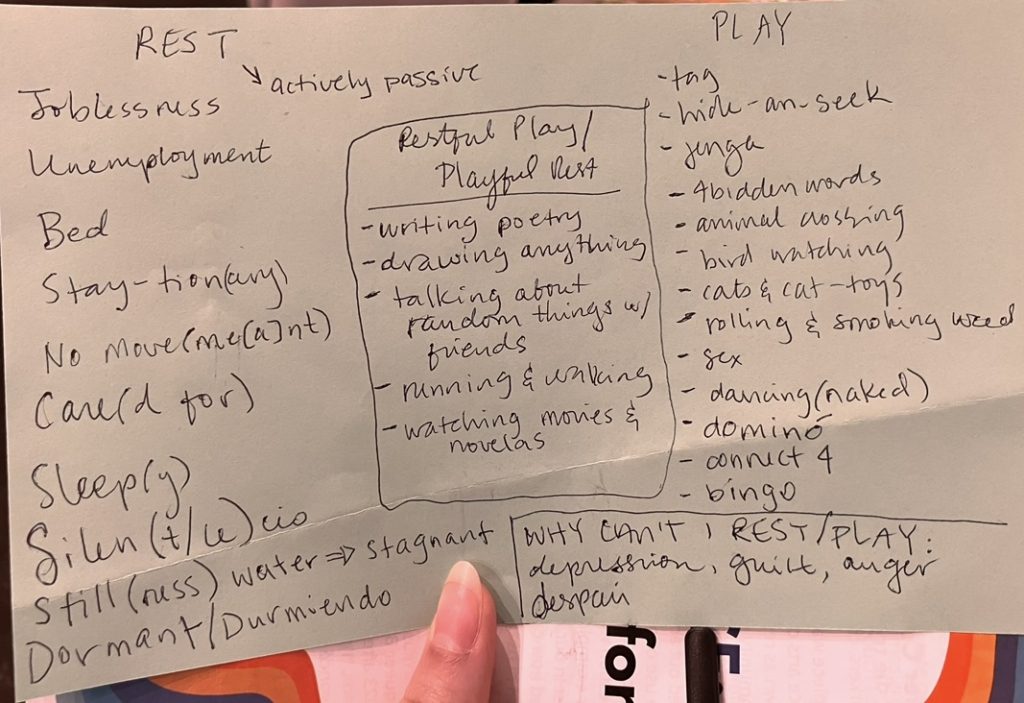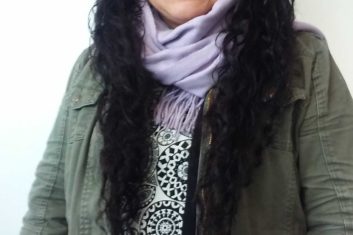sumaiya hernandez alum of the 2023-2024 cycle of the TAP training reflects on the Arts in Education Roundtable: Acts of Rest-istance Art Salón.

Image credit: sumaiya hernandez
After attending the Arts in Education Roundtable: Acts of Rest-istance Art Salón, which took place on February 22nd, the question came forward: what is a teaching artist—and how does one sustain their practice? This event brought to mind questions, ideas and new insights about a teaching artist’s role as teacher, artist, and activist.
Being part of CWP’s 2023-24 TAP Trainees, I was brought into conversations about artivism, the intersection of activist and artistic work, artist and activist sustainability, and how to teach children about the truth of the world—or rather, how to facilitate acknowledging truth with children, for children through inclusive and accessible methods.
Sustainability at the Heart of Activism: Sustaining Our Work as Artists and Activists
![Title plaque for C. Joy Sanchez's mixed-media artwork Game of Tropes [For Black girls who cosplay and love sci-fi/fantacy] (2023).](https://communitywordproject.org/wp-content/uploads/2024/07/IMG_7509-1024x576.jpg)
Image Credit: sumaiya hernandez
Sanchez’s pieces led me to understand that a teaching artist doesn’t abandon reality—theirs, only, or also our collectivereality? We can revisit old projects and give them new meaning. From an activist perspective, this could be likened to cycling through different movements periodically, to ensure your contribution has reach.
By revisiting old projects, we give them a new meaning; not every new piece has to come from scratch or be brand new. This allows artists to rest between conversations with the muse, or processing genocides. They can relax along creation’s path, and take time to play with ideas for their pieces. Also, revisiting old art creates artistic continuity & historicity: works of art then have continuing histories, become artifacts, and embody the subjects they present. C. Joi Sanchez’s art was in conversation with Black futurism, Black joy, Black history and ancestry, Blerds & Game of Thrones, and her own personal experiences. Her pieces are literally ancestors and descendants of themselves ←→ ensuring their future and past in their very existence. To me, for an artist, this is a revolutionary act.
Sustainability & Activism in Art: Photography & “Healing Circles” in Community

Image credit: sumaiya hernandez
Since October 7th, my artistic work and organizing work has revolved around supporting different liberation movements. In response to the multiple genocides and injustices by colonial empires, I took up my camera to photograph protests as a participant and as an archivist/activist/a(r)c(h/t)ivist—or someone who believes in the futurity of realities/y. Another solidarity response—and really just something my community called from me—was teaching poetry by people who are Palestinian, Congolese and Sudanese. In classrooms, I used questions about genocide in Gaza, crafted by a Palestinian poet, to prompt written responses that reflect on institutions keeping us from divesting in the systems that oppress us, and beliefs that either support or hinder liberation.
Considering rest as a form of resistance didn’t sit right with me when I initially encountered the idea, and I’m not sure I’m any less apprehensive to the idea now. But, in my context, resistance and rest feel synonymous: resting from capitalism to focus on work (art and organizing) that advocates liberation and challenges oppression. [At the time of writing this, I’m back in the workforce and have to schedule organizing around making money.] Throughout the event, I didn’t consider that what we were resting from was resistance—not when our existence is resistance—but rather resting from oppressive personal, interpersonal, & systemic thoughts, actions, desires, and designs.
One of the art pieces on display that night was mori-viví style bundles of paper strips with people’s responses to questions about rest, play and joy. In those mori-vivís of paper, I saw bundled the instances when oppression took things—peace (of mind & otherwise), rest, joy—from people, and gave them worry, unrest, death, and something other than joy.
Another thing this event showed me was that though an artist may take a break from their work as artists & activists, that’s not the work we require the most rest from, nor the work that keeps us from play. All the artists at this event were advocating for something: mental health awareness, Black lives (those taken, as well as a celebration of Black lives) Black futurity, and the futurity of Black joy as envisioned by everyone, climate crisis & the undeterred nature of plastic, & the inability to be comfortable with stillness in our ever-pressing, fast-paced society.

Image credit: sumaiya hernandez
None of the subject matter of the art pieces was divesting time away from revolutionary practices. If anything, each art work emphasized a moment within current, past & ongoing revolutions, calling the work done in solidarity rest, play & joy.
From this event, I gathered a mind frame and received confirmation that the work we do for art & activism isn’t work; capitalism is work, and art and activism are sources of joy and resistance to capitalism. Artivism is our response to oppressive systems and a demonstration of rest against oppression. Defining artivism as play doesn’t seem correct to me, unless play is redefined not as a physical embodiment of the fantastical, but as an act of reimagination producing tangible changes in reality. Then, rest, play, and joy make sense to me in an artivist framework as parts of our efforts in resistance against systems of oppression.
Artists don’t rest from revolution; they rest from having to pretend that revolution isn’t necessary, because to be in denial is exhausting.



